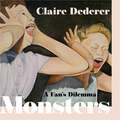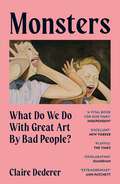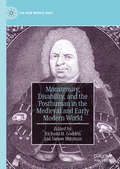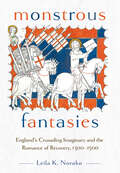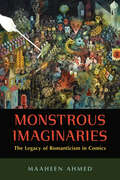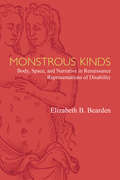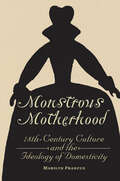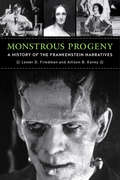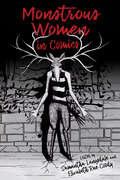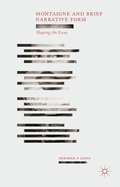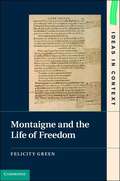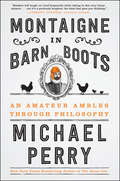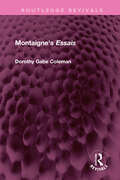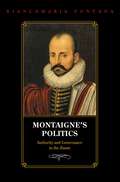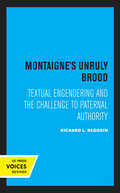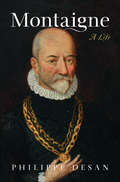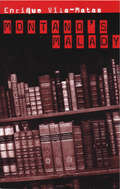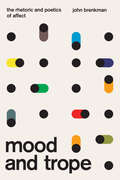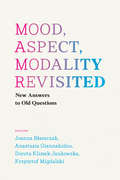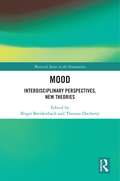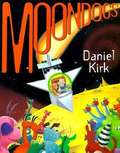- Table View
- List View
Monsters: A Fan’s Dilemma
by Claire DedererA passionate, provocative and blisteringly smart interrogation of how we experience art in the age of #MeToo, and whether we can separate an artist's work from their biography.What do we do with the art of monstrous men? Can we love the work of Roman Polanski and Michael Jackson, Hemingway and Picasso? Should we love it? Does genius deserve special dispensation? Is history an excuse? What makes women artists monstrous? And what should we do with beauty, and with our unruly feelings about it?Claire Dederer explores these questions and our relationships with the artists whose behaviour disrupts our ability to apprehend the work on its own terms. She interrogates her own responses and her own behaviour, and she pushes the fan, and the listener, to do the same. Morally wise, deeply considered and sharply written, Monsters gets to the heart of one of our most pressing conversations.(P) 2023 Penguin Audio
Monsters: A Fan’s Dilemma
by Claire Dederer'An exhilarating, shape-shifting exploration of the perilous boundaries between art and life' JENNY OFFILL'An incredible book, the best work of criticism I have read in a very long time' NICK HORNBY'Wise and bold and full of the kind of gravitas that might even rub off' LISA TADDEOA passionate, provocative and blisteringly smart interrogation of how we experience art in the age of #MeToo, and whether we can separate an artist's work from their biography.What do we do with the art of monstrous men? Can we love the work of Roman Polanski and Michael Jackson, Hemingway and Picasso? Should we love it? Does genius deserve special dispensation? What makes women artists monstrous? And what should we do with beauty, and with our unruly feelings about it?Claire Dederer explores these questions and our relationships with the artists whose behaviour disrupts our ability to understand the work on its own terms. She interrogates her own responses and behaviour, and she pushes the fan, and the reader, to do the same. Morally wise, deeply considered and sharply written, Monsters gets to the heart of one of our most pressing conversations.'A blisteringly erudite and entertaining read . . . It's a book that deserves to be widely read and will provoke many conversations' NATHAN FILER'Fascinating . . . Dederer poses so many topical questions, plays with so many pertinent ideas, that I'm still thinking about this book long after I finished it' CLAIRE FULLER
Monstrosity, Disability, and the Posthuman in the Medieval and Early Modern World (The New Middle Ages)
by Richard H. Godden Asa Simon MittmanThis collection examines the intersection of the discourses of “disability” and “monstrosity” in a timely and necessary intervention in the scholarly fields of Disability Studies and Monster Studies. Analyzing Medieval and Early Modern art and literature replete with images of non-normative bodies, these essays consider the pernicious history of defining people with distinctly non-normative bodies or non-normative cognition as monsters. In many cases throughout Western history, a figure marked by what Rosemarie Garland-Thomson has termed “the extraordinary body” is labeled a “monster.” This volume explores the origins of this conflation, examines the problems and possibilities inherent in it, and casts both disability and monstrosity in light of emergent, empowering discourses of posthumanism.
Monstrous Fantasies: England's Crusading Imaginary and the Romance of Recovery, 1300-1500
by Leila K. NorakoMonstrous Fantasies asks why medieval romances reimagining the crusades ending in a Christian victory circulated in England with such abundance after the 1291 Muslim reconquest of Acre, the last of the Latin crusader states in the Holy Land, and what these texts reveal about the cultural anxieties of late medieval England. Leila K. Norako highlights the impact that the Ottoman victory and subsequent massacre of Christian prisoners at the battle of Nicopolis in 1396 had on intensifying the popularity of what she calls recovery romance. These two episodes inspired a sense of urgency over the fate of the Holy Land and of Latin Christendom itself, resulting in the proliferation of romances in which crusading English kings like Richard I and anachronistic legends like King Arthur not only reconquered Jerusalem but committed genocidal violence against the Muslims. These romances, which—as Norako argues—also influenced Geoffrey Chaucer's Canterbury Tales, conjure fantasies of an ascendant global Christendom by rehearsing acts of conquest and cultural annihilation that were impossible to realize in the late Middle Ages. Emphasizing the tension in these texts between nostalgia and anticipation that fuels their narrative momentum, Monstrous Fantasies also explores how the cultural desires for European and Christian hegemony that recovery romances versified were revived in the wake of the so-called wars on terror in the twenty-first century in such films as Kingdom of Heaven and American Sniper.
Monstrous Imaginaries: The Legacy of Romanticism in Comics
by Maaheen AhmedMonsters seem inevitably linked to humans and not always as mere opposites. Maaheen Ahmed examines good monsters in comics to show how Romantic themes from the eighteenth and the nineteenth centuries persist in today’s popular culture. Comics monsters, questioning the distinction between human and monster, self and other, are valuable conduits of Romantic inclinations. Engaging with Romanticism and the many monsters created by Romantic writers and artists such as Mary Shelley, Victor Hugo, and Goya, Ahmed maps the heritage, functions, and effects of monsters in contemporary comics and graphic novels. She highlights the persistence of recurrent Romantic features through monstrous protagonists in English- and French-language comics and draws out their implications. Aspects covered include the dark Romantic predilection for ruins and the sordid, the solitary protagonist and his quest, nostalgia, the prominence of the spectacle as well as excessive emotions, and above all, the monster’s ambiguity and rebelliousness. Ahmed highlights each Romantic theme through close readings of well-known but often overlooked comics, including Enki Bilal's Monstre tetralogy, Jim O'Barr's The Crow, and Emil Ferris’s My Favorite Thing Is Monsters, as well as the iconic comics series Alan Moore's Swamp Thing and Mike Mignola's Hellboy. In blurring the otherness of the monster, these protagonists retain the exaggeration and uncontrollability of all monsters while incorporating Romantic characteristics.
Monstrous Kinds: Body, Space, and Narrative in Renaissance Representations of Disability (Corporealities: Discourses Of Disability)
by Elizabeth BeardenMonstrous Kinds is the first book to explore textual representations of disability in the global Renaissance. Elizabeth B. Bearden contends that monstrosity, as a precursor to modern concepts of disability, has much to teach about our tendency to inscribe disability with meaning. Understanding how early modern writers approached disability not only provides more accurate genealogies of disability, but also helps nuance current aesthetic and theoretical disability formulations. The book analyzes the cultural valences of early modern disability across a broad national and chronological span, attending to the specific bodily, spatial, and aesthetic systems that contributed to early modern literary representations of disability. The cross section of texts (including conduct books and treatises, travel writing and wonder books) is comparative, putting canonical European authors such as Castiglione into dialogue with transatlantic and Anglo-Ottoman literary exchange. Bearden questions grand narratives that convey a progression of disability from supernatural marvel to medical specimen, suggesting that, instead, these categories coexist and intersect.
Monstrous Motherhood: Eighteenth-Century Culture and the Ideology of Domesticity
by Marilyn FrancusSpectral and monstrous mothers populate the cultural and literary landscape of the eighteenth century, overturning scholarly assumptions about this being an era of ideal motherhood.Although credited with the rise of domesticity, eighteenth-century British culture singularly lacked narratives of good mothers, ostensibly the most domestic of females. With startling frequency, the best mother was absent, disembodied, voiceless, or dead. British culture told tales almost exclusively of wicked, surrogate, or spectral mothers—revealing the defects of domestic ideology, the cultural fascination with standards and deviance, and the desire to police maternal behaviors. Monstrous Motherhood analyzes eighteenth-century motherhood in light of the inconsistencies among domestic ideology, narrative, and historical practice. If domesticity was so important, why is the good mother’s story absent or peripheral? What do the available maternal narratives suggest about domestic ideology and the expectations and enactment of motherhood? By focusing on literary and historical mothers in novels, plays, poems, diaries, conduct manuals, contemporary court cases, realist fiction, fairy tales, satire, and romance, Marilyn Francus reclaims silenced maternal voices and perspectives. She exposes the mechanisms of maternal marginalization and spectralization in eighteenth-century culture and revises the domesticity thesis.Monstrous Motherhood will compel scholars in eighteenth-century studies, women’s studies, family history, and cultural studies to reevaluate a foundational assumption that has driven much of the discourse in their fields.
Monstrous Progeny: A History of the Frankenstein Narratives
by Lester D. Friedman Allison B. KaveyMary Shelley's 1818 novel Frankenstein is its own type of monster mythos that will not die, a corpus whose parts keep getting harvested to animate new artistic creations. What makes this tale so adaptable and so resilient that, nearly 200 years later, it remains vitally relevant in a culture radically different from the one that spawned its birth? Monstrous Progeny takes readers on a fascinating exploration of the Frankenstein family tree, tracing the literary and intellectual roots of Shelley's novel from the sixteenth century and analyzing the evolution of the book's figures and themes into modern productions that range from children's cartoons to pornography. Along the way, media scholar Lester D. Friedman and historian Allison B. Kavey examine the adaptation and evolution of Victor Frankenstein and his monster across different genres and in different eras. In doing so, they demonstrate how Shelley's tale and its characters continue to provide crucial reference points for current debates about bioethics, artificial intelligence, cyborg lifeforms, and the limits of scientific progress. Blending an extensive historical overview with a detailed analysis of key texts, the authors reveal how the Frankenstein legacy arose from a series of fluid intellectual contexts and continues to pulsate through an extraordinary body of media products. Both thought-provoking and entertaining, Monstrous Progeny offers a lively look at an undying and significant cultural phenomenon.
Monstrous Women in Comics (Horror and Monstrosity Studies Series)
by Samantha Langsdale and Elizabeth Rae CoodyContributions by Novia Shih-Shan Chen, Elizabeth Rae Coody, Keri Crist-Wagner, Sara Durazo-DeMoss, Charlotte Johanne Fabricius, Ayanni C. Hanna, Christina M. Knopf, Tomoko Kuribayashi, Samantha Langsdale, Jeannie Ludlow, Marcela Murillo, Sho Ogawa, Pauline J. Reynolds, Stefanie Snider, J. Richard Stevens, Justin Wigard, Daniel F. Yezbick, and Jing Zhang Monsters seem to be everywhere these days, in popular shows on television, in award-winning novels, and again and again in Hollywood blockbusters. They are figures that lurk in the margins and so, by contrast, help to illuminate the center—the embodiment of abnormality that summons the definition of normalcy by virtue of everything they are not. Samantha Langsdale and Elizabeth Rae Coody’s edited volume explores the coding of woman as monstrous and how the monster as dangerously evocative of women/femininity/the female is exacerbated by the intersection of gender with sexuality, race, nationality, and disability. To analyze monstrous women is not only to examine comics, but also to witness how those constructions correspond to women’s real material experiences. Each section takes a critical look at the cultural context surrounding varied monstrous voices: embodiment, maternity, childhood, power, and performance. Featured are essays on such comics as Faith, Monstress, Bitch Planet, and Batgirl and such characters as Harley Quinn and Wonder Woman. This volume probes into the patriarchal contexts wherein men are assumed to be representative of the normative, universal subject, such that women frequently become monsters.
Monstrous Work and Radical Satisfaction: Black Women Writing under Segregation
by Eve DunbarRadical Black feminist refusal through the works of mid-twentieth-century African American women writers Monstrous Work and Radical Satisfaction offers new and insightful readings of African American women&’s writings in the 1930s–1950s, illustrating how these writers centered Black women&’s satisfaction as radical resistance to the false and incomplete promise of liberal racial integration. Eve Dunbar examines the writings of Ann Petry, Dorothy West, Alice Childress, and Gwendolyn Brooks to show how these women explored self-fulfillment over normative and sanctioned models of national belonging. Paying close attention to literary moments of disruption, miscommunication, or confusion rather than ease, assimilation, or mutual understanding around race and gender, Dunbar tracks these writers&’ dissatisfaction with American race relations. She shows how Petry, West, Childress, and Brooks redeploy the idea of monstrous work to offer potential modalities for registering Black women&’s capacity to locate satisfaction within the domestic and interpersonal. While racial integration may satisfy the national idea of equality and inclusion, it has not met the long-term needs of Black people&’s quest for equity. Dunbar responds, demonstrating how these mid-century women offer new blueprints for Black life by creating narrative models for radical satisfaction: Black women&’s completeness, joy, and happiness outside the bounds of normative racial inclusion.
Montaigne and Brief Narrative Form
by Deborah N. LosseThe first book-length study to trace the origins of the essay to the conte, Montaigne and Brief Narrative Form puts the reader in touch with how unstable times and exceptional artistic insights transform one genre to create a new artistic form.
Montaigne and the Life of Freedom
by Felicity GreenMore than any other early modern text, Montaigne's Essais have come to be associated with the emergence of a distinctively modern subjectivity, defined in opposition to the artifices of language and social performance. Felicity Green challenges this interpretation with a compelling revisionist reading of Montaigne's text, centred on one of his deepest but hitherto most neglected preoccupations: the need to secure for himself a sphere of liberty and independence that he can properly call his own, or himself. Montaigne and the Life of Freedom restores the Essais to its historical context by examining the sources, character and significance of Montaigne's project of self-study. That project, as Green shows, reactivates and reshapes ancient practices of self-awareness and self-regulation, in order to establish the self as a space of inner refuge, tranquillity and dominion, free from the inward compulsion of the passions and from subjection to external objects, forces and persons.
Montaigne in Barn Boots: An Amateur Ambles Through Philosophy
by Michael PerryThe beloved memoirist and bestselling author of Population: 485 reflects on the lessons he’s learned from his unlikely alter ego, French Renaissance philosopher Michel de Montaigne."The journey began on a gurney," writes Michael Perry, describing the debilitating kidney stone that led him to discover the essays of Michel de Montaigne. Reading the philosopher in a manner he equates to chickens pecking at scraps—including those eye-blinking moments when the bird gobbles something too big to swallow—Perry attempts to learn what he can (good and bad) about himself as compared to a long-dead French nobleman who began speaking Latin at the age of two, went to college instead of kindergarten, worked for kings, and once had an audience with the Pope. Perry "matriculated as a barn-booted bumpkin who still marks a second-place finish in the sixth-grade spelling bee as an intellectual pinnacle . . . and once said hello to Merle Haggard on a golf cart."Written in a spirit of exploration rather than declaration, Montaigne in Barn Boots is a down-to-earth (how do you pronounce that last name?) look into the ideas of a philosopher "ensconced in a castle tower overlooking his vineyard," channeled by a midwestern American writing "in a room above the garage overlooking a disused pig pen." Whether grabbing an electrified fence, fighting fires, failing to fix a truck, or feeding chickens, Perry draws on each experience to explore subjects as diverse as faith, race, sex, aromatherapy, and Prince. But he also champions academics and aesthetics, in a book that ultimately emerges as a sincere, unflinching look at the vital need to be a better person and citizen.
Montaigne's 'Essais' (Routledge Revivals)
by Dorothy Gabe ColemanThis book, first published in 1987, is an examination of Montaigne’s Essais and a guide to the reading of this fascinating, stimulating and imaginative writer – a writer who is also difficult to read and interpret. This book’s aim is to help the reader of Montaigne understand that their own experiences of life and literature can be brought to bear to help comprehend the true meaning of Montaigne.
Montaigne's Politics: Authority and Governance in the Essais
by Biancamaria FontanaMichel de Montaigne (1533-92) is principally known today as a literary figure--the inventor of the modern essay and the pioneer of autobiographical self-exploration who retired from politics in midlife to write his private, philosophical, and apolitical Essais. But, as Biancamaria Fontana argues in Montaigne's Politics, a novel, vivid account of the political meaning of the Essais in the context of Montaigne's life and times, his retirement from the Bordeaux parliament in 1570 "could be said to have marked the beginning, rather than the end, of his public career." He later served as mayor of Bordeaux and advisor to King Henry of Navarre, and, as Fontana argues, Montaigne's Essais very much reflect his ongoing involvement and preoccupation with contemporary politics--particularly the politics of France's civil wars between Catholics and Protestants. Fontana shows that the Essais, although written as a record of Montaigne's personal experiences, do nothing less than set forth the first major critique of France's ancien régime, anticipating the main themes of Enlightenment writers such as Voltaire and Diderot. Challenging the views that Montaigne was politically aloof or evasive, or that he was a conservative skeptic and supporter of absolute monarchy, Fontana explores many of the central political issues in Montaigne's work--the reform of legal institutions, the prospects of religious toleration, the role of public opinion, and the legitimacy of political regimes.
Montaigne's Unruly Brood: Textual Engendering and the Challenge to Paternal Authority
by Richard L. RegosinPerhaps as old as writing itself, the metaphor of the book as child has depicted textuality as an only son conceived to represent its father uniformly and to assure the integrity of his name. Richard L. Regosin demonstrates how Montaigne's Essais both departs from and challenges this conventional figure of textuality. He argues that Montaigne's writing is best described as a corpus of siblings with multiple faces and competing voices, a hybrid textuality inclined both to truth and dissimulation, to faithfulness and betrayal, to form and deformation. And he analyzes how this unruly, mixed brood also discloses a sexuality and gender dynamic in the Essais that is more conflicted than the traditional metaphor of literary paternity allows. Regosin challenges traditional critics by showing how the "logic" of a faithful filial text is disrupted and how the writing self displaces the author's desire for mastery and totalization. He approaches the Essais from diverse critical and theoretical perspectives that provide new ground for understanding both Montaigne's complex textuality and the obtrusive reading that it simultaneously invites and resists. His analysis is informed by poststructuralist criticism, by reception theory, and by gender and feminist studies, yet at the same time he treats the Essais as a child of sixteenth-century Humanism and late Renaissance France. Regosin also examines Montaigne's self-proclaimed taste for Ovid and the role played by the seminal texts of self-representation and aesthetic conception (Narcissus and Pygmalion) and the myth of sexual metamorphosis (Iphis). This title is part of UC Press's Voices Revived program, which commemorates University of California Press’s mission to seek out and cultivate the brightest minds and give them voice, reach, and impact. Drawing on a backlist dating to 1893, Voices Revived makes high-quality, peer-reviewed scholarship accessible once again using print-on-demand technology. This title was originally published in 1966.
Montaigne: A Life
by Steven Rendall Lisa Neal Philippe DesanOne of the most important writers and thinkers of the Renaissance, Michel de Montaigne (1533–92) helped invent a literary genre that seemed more modern than anything that had come before. But did he do it, as he suggests in his Essays, by retreating to his chateau, turning his back on the world, and stoically detaching himself from his violent times? In this definitive biography, Philippe Desan, one of the world's leading authorities on Montaigne, overturns this longstanding myth by showing that Montaigne was constantly concerned with realizing his political ambitions—and that the literary and philosophical character of the Essays largely depends on them. The most comprehensive and authoritative biography of Montaigne yet written, this sweeping narrative offers a fascinating new picture of his life and work.As Desan shows, Montaigne always considered himself a political figure and he conceived of each edition of the Essays as an indispensable prerequisite to the next stage of his public career. He lived through eight civil wars, successfully lobbied to be raised to the nobility, and served as mayor of Bordeaux, special ambassador, and negotiator between Henry III and Henry of Navarre. It was only toward the very end of Montaigne’s life, after his political failure, that he took refuge in literature. But, even then, it was his political experience that enabled him to find the right tone for his genre.In this essential biography, we discover a new Montaigne—caught up in the events of his time, making no separation between private and public life, and guided by strategy first in his words and silences. Neither candid nor transparent, but also not yielding to the cynicism of his age, this Montaigne lends a new depth to the Montaigne of literary legend.
Montano's Malady
by Enrique Vila-Matas Jonathan DunneA quirky, cosmopolitan novel about life and literature by the prize-winning Spanish writer Enrique Vila-Matas, author of Bartleby & Co. The narrator of Montano’s Malady is a writer named Jose who is so obsessed with literature that he finds it impossible to distinguish between real life and fictional reality. Part picaresque novel, part intimate diary, part memoir and philosophical musings, Enrique Vila-Matas has created a labyrinth in which writers as various as Cervantes, Sterne, Kafka, Musil, Bolano, Coetzee, and Sebald cross endlessly surprising paths. Trying to piece together his life of loss and pain, Jose leads the reader on an unsettling journey from European cities such as Nantes, Barcelona, Lisbon, Prague and Budapest to the Azores and the Chilean port of Valparaiso. Exquisitely witty and erudite, it confirms the opinion of Bernardo Axtaga that Vila-Matas is "the most important living Spanish writer."
Monuments and Literary Posterity in Early Modern Drama
by Brian ChalkIn spite of the ephemeral nature of performed drama, playwrights such as Marlowe, Jonson, Webster, Fletcher, and Shakespeare were deeply interested in the endurance of their theatrical work and in their own literary immortality. This book re-evaluates the relationship between these early modern dramatists and literary posterity by considering their work within the context of post-Reformation memorialization. Providing fresh analyses of plays by major dramatists, Brian Chalk considers how they depicted monuments and other funeral properties on stage in order to exploit and criticize the rich ambiguities of commemorative rituals. The book also discusses the print history of the plays featured. The subject will attract scholars and upper-level students of Renaissance drama, memory studies, early modern theatre, and print history.
Mood and Trope: The Rhetoric and Poetics of Affect
by John Brenkman“Reconnect[s] affect studies with major issues in literary studies, philosophy, and aesthetics. . . . a fundamental contribution to this emergent field.” —Jonathan Culler, Cornell University, author of Structuralist PoeticsIn Mood and Trope, John Brenkman introduces two provocative propositions to affect theory: that human emotion is intimately connected to persuasion and figurative language; and that literature, especially poetry, lends precision to studying affect because it resides there not in speaking about feelings, but in the way of speaking itself.Engaging modern philosophers—Kant, Nietzsche, Heidegger, and Deleuze—Brenkman explores how they all approach the question of affect primarily through literature and art. He draws on the differences and dialogues among them, arguing that the vocation of criticism is incapable of systematicity and instead must be attuned to the singularity and plurality of literary and artistic creations. In addition, he confronts these four philosophers and their essential concepts with a wide array of authors and artists, including Pinter and Poe, Baudelaire, Jorie Graham and Li-Young Lee, Shakespeare, Tino Sehgal, and Francis Bacon. Filled with surprising insights, Mood and Trope provides a rich archive for rethinking the nature of affect and its aesthetic and rhetorical stakes.“Combining philosophical inquiry with brilliant interpretive readings, Brenkman, draws out the distinctive imbrications of mood and trope across a range of modern poetic projects.” —Amanda Anderson, Brown University, author of Psyche and Ethos“Brenkman shows us how literature has extended and deepened the possibilities of feeling and knowledge of feeling alike.” —Susan Stewart, Princeton University, author of The Open Studio: Essays on Art and Aesthetics“Eminently readable.” —Choice
Mood, Aspect, Modality Revisited: New Answers to Old Questions
by Joanna Błaszczak, Anastasia Giannakidou, Dorota Klimek-Jankowska, Krzysztof MigdalskiOver the past several decades, linguistic theorizing of tense, aspect, and mood (TAM), along with a strongly growing body of crosslinguistic studies, has revealed complexity in the data that challenges traditional distinctions and treatments of these categories. Mood, Aspect, Modality Revisited argues that it’s time to revisit our conventional assumptions and reconsider our foundational questions: What exactly is a linguistic category? What kinds of categories do labels such as “subjunctive,” “imperative,” “future,” and “modality” truly refer to? In short, how categorical are categories? Current literature assumes a straightforward link between grammatical category and semantic function, and descriptions of well-studied languages have cultivated a sense of predictability in patterns over time. As the editors and contributors of Mood, Aspect, Modality Revisited prove, however, this predictability and stability vanish in the study of lesser-known patterns and languages. The ten provocative essays gathered here present fascinating cutting-edge research demonstrating that the traditional grammatical distinctions are ultimately fluid—and perhaps even illusory. Developing groundbreaking and highly original theories, the contributors in this volume seek to unravel more general, fundamental principles of TAM that can help us better understand the nature of linguistic representations.
Mood: Interdisciplinary Perspectives, New Theories (Warwick Series in the Humanities)
by Thomas Docherty Birgit BreidenbachMood is a phenomenon whose study is inherently interdisciplinary. While it has remained resistant to theorisation, it nonetheless has a substantial influence on art, politics and society. Since its practical omnipresence in every-day life renders it one of the most significant aspects of affect studies, it has garnered an increasing amount of critical attention in a number of disciplines across the humanities, sciences and social sciences in the past two decades. Mood: Aesthetics, Psychology, Philosophy provides a comprehensive theoretical and empirical exploration of the phenomenon of mood from an interdisciplinary angle. Building on cutting-edge research in this emerging field and bringing together established and new voices, it bridges the existing disciplinary gap in the study of mood and further consolidates this phenomenon as a crucial concept in disciplinary and interdisciplinary study. By combining perspectives and concepts from the literary studies, philosophy, musicology, the social sciences, artistic practice and psychology, the volume does the complexity and richness of mood-related phenomena justice and benefits from the latent connections and synergies in different disciplinary approaches to the study of mood.
Moondogs
by Daniel KirkThere are amazing-looking dogs on the moon! Young Willy knows because he has been watching them through his telescope. When his dad suggests he ought to have a pet, Willy builds a rocket just his size, and sets off on the adventure of a lifetime. Willy's heart is set on finding a dog like you've never seen before and readers will be surprised to see what he brings home!
Moral Authority, Men of Science, and the Victorian Novel
by Anne DewittNineteenth-century men of science aligned scientific practice with moral excellence as part of an endeavor to secure cultural authority for their discipline. Anne DeWitt examines how novelists from Elizabeth Gaskell to H. G. Wells responded to this alignment. Revising the widespread assumption that Victorian science and literature were part of one culture, she argues that the professionalization of science prompted novelists to deny that science offered widely accessible moral benefits. Instead, they represented the narrow aspirations of the professional as morally detrimental while they asserted that moral concerns were the novel's own domain of professional expertise. This book draws on works of natural theology, popular lectures, and debates from the pages of periodicals to delineate changes in the status of science and to show how both familiar and neglected works of Victorian fiction sought to redefine the relationship between science and the novel.
Moral Combat: Women, Gender, and War in Italian Renaissance Literature (Toronto Italian Studies)
by Gerry MilliganThe Italian sixteenth century offers the first sustained discussion of women’s militarism since antiquity. Across a variety of genres, male and female writers raised questions about women’s right and ability to fight in combat. Treatise literature engaged scientific, religious, and cultural discourses about women’s virtues, while epic poetry and biographical literature famously featured examples of women as soldiers, commanders, observers, and victims of war. Moral Combat asks how and why women’s militarism became one of the central discourses of this age. Gerry Milligan discusses the armed heroines of biography and epic within the context of contemporary debates over women’s combat abilities and men’s martial obligations. Women are frequently described as fighting because men have failed their masculine duty. A woman’s prowess at arms was asserted to be a cultural symptom of men’s shortcomings. Moral Combat ultimately argues that the popularity of the warrior woman in sixteenth-century Italian literature was due to her dual function of shame and praise: calling men to action and signaling potential victory to a disempowered people.
